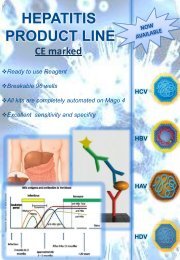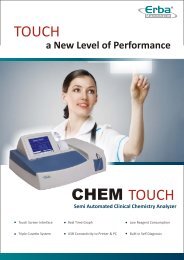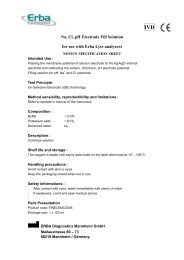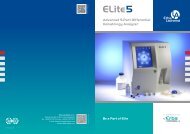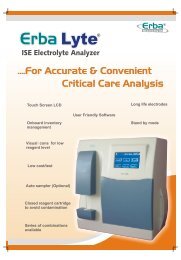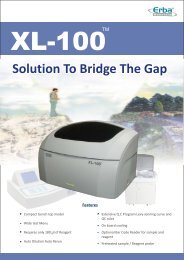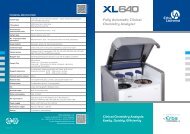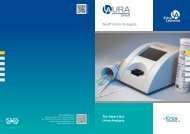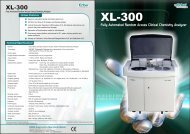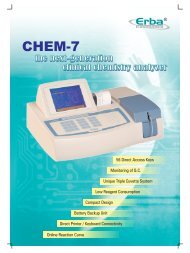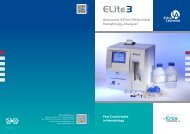mikro la test - Erba Mannheim
mikro la test - Erba Mannheim
mikro la test - Erba Mannheim
You also want an ePaper? Increase the reach of your titles
YUMPU automatically turns print PDFs into web optimized ePapers that Google loves.
Microbial Identification
Standard in microbial identification<br />
<strong>Erba</strong> Lachema s.r.o., a traditional producer and supplier of diagnostic products for clinical <strong>la</strong>boratories,<br />
offers an advanced range of products for microbial identification. The products have been designed to<br />
cover the requirements of our users for:<br />
• reliability of the identification<br />
• highly standardized procedure<br />
• working comfort<br />
MIKRO-LA-TEST ® products include:<br />
1. Identification kits .............................................................................................................. 4<br />
2. Products for water microbiology ............................................................................... 13<br />
3. Additional preparations ................................................................................................ 16<br />
• Reagents ....................................................................................................................... 16<br />
• Suspension media ...................................................................................................... 16<br />
• Identification aids ........................................................................................................17<br />
4. Detection strips .............................................................................................................. 19<br />
5. Diagnostic discs .............................................................................................................22<br />
6. Instruments and devices ..............................................................................................23<br />
Identification kits MIKRO-LA-TEST ®<br />
MIKRO-LA-TEST ® identification kits are the most important component of the standardized micromethod<br />
system for rapid, reliable routine identification of the most clinically important bacteria and yeasts.<br />
Principle<br />
Identification kits contain dehydrated substrates for biochemicals reactions.<br />
Design of kits<br />
Kits are p<strong>la</strong>ced on divided microp<strong>la</strong>tes with 1, 2 or 3-row strips for 8, 16 or 24 reactions. This<br />
arrangement enables to use only a relevant part of the p<strong>la</strong>te, corresponding to the number of<br />
examined strains. Identification can be supplemented with <strong>test</strong>s avai<strong>la</strong>ble in the form of detection strips<br />
MIKRO-LA-TEST ® . Results can be evaluated either visualy or automatically using our reader.<br />
3
Identification kits and re<strong>la</strong>ted products – overview<br />
Kit<br />
Nr.<br />
of <strong>test</strong>s<br />
Necessary<br />
reagents and aids<br />
Recommended additional<br />
strip or disc <strong>test</strong>ing<br />
Recommended additional items<br />
for identification<br />
Results reading<br />
/ hours after<br />
inocu<strong>la</strong>tion<br />
ENTERO<strong>test</strong> 24 N 40 Paraffin oil<br />
INDOL<strong>test</strong><br />
VP<strong>test</strong><br />
Reagent for ACETOIN<br />
OXI<strong>test</strong><br />
Reagent for OXI<strong>test</strong><br />
TNW software<br />
24 hours<br />
ENTERO<strong>test</strong> 16 60<br />
Indol<br />
Pheny<strong>la</strong><strong>la</strong>nine<br />
Paraffin oil<br />
OXI<strong>test</strong><br />
Reagent for OXI<strong>test</strong><br />
ONP<strong>test</strong><br />
COLI<strong>test</strong><br />
VP <strong>test</strong><br />
Reagent for ACETOIN<br />
Colour scale for ENTERO<strong>test</strong> 16<br />
Code book for ENTERO<strong>test</strong> 16<br />
or TNW software<br />
24 hours<br />
ENTERO-Screen 36<br />
Acetoin<br />
Pheny<strong>la</strong><strong>la</strong>nin<br />
Indol<br />
Paraffin oil<br />
OXI<strong>test</strong><br />
COLI<strong>test</strong><br />
PYRA<strong>test</strong><br />
Reagent for PYR<strong>test</strong><br />
Colour scale for ENTERO-Screen<br />
Code book included in the kit<br />
4 hours<br />
ENTERO-Rapid 24 40<br />
Indol<br />
Acetoin<br />
Phosphatase<br />
Pyr<br />
Paraffin oil<br />
OXI<strong>test</strong><br />
Reagent for OXI<strong>test</strong><br />
Colour scale for ENTERO-Rapid 24<br />
Code book for ENTERO-Rapid 24<br />
or TNW software<br />
4 hours<br />
STAPHY<strong>test</strong> 24 40 Paraffin oil<br />
OXI<strong>test</strong><br />
Reagent for OXI<strong>test</strong><br />
VP<strong>test</strong><br />
Reagent for ACETOIN<br />
PYRA<strong>test</strong><br />
Reagent for PYR<strong>test</strong><br />
NOVOBIOCIN disc<br />
BACITRACIN S disc<br />
Colour scale for STAPHY<strong>test</strong> 24<br />
Code book for STAPHY<strong>test</strong> 24<br />
or TNW software<br />
24 hours<br />
STAPHY<strong>test</strong> 16 60<br />
Phosphatase<br />
Nitrate<br />
Paraffin oil<br />
VP<strong>test</strong><br />
Reagent for ACETOIN<br />
OXI<strong>test</strong><br />
Reagent for OXI<strong>test</strong><br />
PYRA<strong>test</strong><br />
Reagent for PYR<strong>test</strong><br />
NOVOBIOCIN disc<br />
Colour scale for STAPHY<strong>test</strong> 16<br />
Code book for STAPHY<strong>test</strong> 16<br />
or TNW software<br />
24 hours<br />
STREPTO<strong>test</strong> 24 40<br />
Suspension medium<br />
for STREPTO<strong>test</strong> 24<br />
Paraffine oil<br />
HIPPURATE<strong>test</strong><br />
Reagent for HIPPURATE<strong>test</strong><br />
PYRA<strong>test</strong><br />
Reagent for PYR<strong>test</strong><br />
VP<strong>test</strong><br />
Reagent for ACETOIN<br />
Code book for STREPTO<strong>test</strong> 24<br />
or TNW software<br />
24 hours<br />
EN-COCCUS<strong>test</strong> 36 Paraffin oil<br />
PYRA<strong>test</strong><br />
Regent for PYR<strong>test</strong><br />
Color scale for EN-COCCUS<strong>test</strong><br />
Code book included in the kit<br />
24 hours<br />
NEFERM<strong>test</strong> 24 40 Paraffin oil<br />
OXI<strong>test</strong><br />
Reagent for OXI<strong>test</strong><br />
OF <strong>test</strong><br />
TNW software<br />
24 hours<br />
ANAERO<strong>test</strong> 23 40<br />
Indol<br />
Nitrate<br />
Bromcrezol red<br />
Suspension medium<br />
for ANAERO<strong>test</strong> 23<br />
Paraffin oil<br />
Colour scale for ANAERO<strong>test</strong> 23<br />
Code book for ANAERO<strong>test</strong> 23<br />
or TNW software<br />
24-48 hours<br />
NEISSERIA<strong>test</strong> 36<br />
Suspension medium<br />
for NEISSERIA<strong>test</strong><br />
ONP<strong>test</strong><br />
OXI<strong>test</strong><br />
Reagent for OXI<strong>test</strong><br />
V+K disc<br />
Colour scale for NEISSERIA<strong>test</strong><br />
Code book included in the kit<br />
4-24 hours<br />
Identification kits<br />
URE-HP<strong>test</strong> 288 Paraffin oil<br />
CANDIDA<strong>test</strong> 21<br />
CANDIDA-Screen<br />
20<br />
36 Paraffin oil<br />
Morphology<br />
Morphology<br />
Colour scale for CANDIDA<strong>test</strong> 21<br />
or TNW software<br />
Code book included in the kit<br />
Up to 4 hour<br />
depending on<br />
urease activity<br />
24 hours<br />
24 hours<br />
OF<strong>test</strong> 288 Paraffin oil 2-4 hours<br />
4
ENTERO<strong>test</strong> 24 N<br />
ENTERO<strong>test</strong> 24 N is a non-reagent <strong>test</strong> designed for routine, definitive identification of important strains of<br />
family Enterobacteriaceae and Vibrionaceae within 24 hours. The kit contains 24 biochemical <strong>test</strong>s, which are<br />
p<strong>la</strong>ced in 3 rows (triple-strips) of a divided microp<strong>la</strong>te. The identification can be supplemented with the <strong>test</strong>s<br />
avai<strong>la</strong>ble in the form of detection strips MIKRO-LA-TEST: OXI<strong>test</strong> for detection of cytochromoxidase, OF<strong>test</strong><br />
to differenciate Enterobacteriaceae and nonfermenting bacteria, INDOL<strong>test</strong> for detection of tryptophanase<br />
activity and VP<strong>test</strong> for detection of acetoin formation. One kit of ENTERO<strong>test</strong> 24 N provides 40 determinations.<br />
Cat. nr. Preparation name Nr. of exam.<br />
10020290 ENTERO<strong>test</strong> 24 N 40<br />
10003371 Paraffin oil, sterilized 100 100<br />
10010255 INDOL<strong>test</strong> 50<br />
10003329 VP<strong>test</strong> 50<br />
10003369 Reagent for ACETOIN <strong>test</strong> 90<br />
10003324 OXI<strong>test</strong> 50<br />
10003379 Reagent for OXIDASE <strong>test</strong> 250<br />
10010256 OF<strong>test</strong> 288<br />
Code Book / TNW:<br />
Budvicia aquatica, Buttiauxel<strong>la</strong> agrestis, Buttiaxel<strong>la</strong> brennerae, Buttiaxel<strong>la</strong> ferragutiae, Buttiaxel<strong>la</strong> gaviniae, Buttiaxel<strong>la</strong> izardii, Buttiaxel<strong>la</strong><br />
noackiae, Buttiaxel<strong>la</strong> warmboldiae, Cedecea davisae, Cedecea <strong>la</strong>pagei, Cedecea neteri, Citrobacter amalonaticus, Citrobacter braakii,<br />
Citrobacter farmeri, Citrobacter freundii, Citrobacter gillenii, Citrobacter koseri, Citrobacter murliniae, Citrobacter rodentium, Citrobacter<br />
sed<strong>la</strong>kii, Citrobacter werkmanii, Citrobacter youngae, Cronobacter (Enterobacter) sakazakii, Edwardsiel<strong>la</strong> hoshinae, Edwardsiel<strong>la</strong> ictaluri,<br />
Edwardsiel<strong>la</strong> tarda, Enterobacter aerogenes, Enterobacter amnigenus biovar 1, Enterobacter amnigenus biovar 2, Enterobacter asburiae,<br />
Enterobacter cancerogenus, Enterobacter cloacae subsp. cloacae, Enterobacter cloacae subsp. dissolvens, Enterobacter gergoviae,<br />
Enterobacter hormaechei, Enterobacter kobei, Enterobacter nimipressuralis, Enterobacter pyrinus, Escherichia coli, Escherichia<br />
fergusonii, Escherichia hermannii, Escherichia vulneris, Ewingel<strong>la</strong> americana, Hafnia alvei, Hafnia alvei biovar 1, Klebsiel<strong>la</strong> oxytoca, Klebsiel<strong>la</strong><br />
pneumoniae subs.ozaenae, Klebsiel<strong>la</strong> pneumoniae subs. pneumonie, Klebsiel<strong>la</strong> pneumoniae subs. rhinoscleromatis, Kluyvera ascorbata,<br />
Kluyvera cryocrescens, Kluyvera georgiana, Kluyvera intermedia, Leclercia adecarboxy<strong>la</strong>ta, Leminorel<strong>la</strong> grimontii, Leminorel<strong>la</strong> richardii,<br />
Moellerel<strong>la</strong> wisconsensis, Morganel<strong>la</strong> morganii subs. morganii, Morganel<strong>la</strong> morganii subs. sibonii, Obesumbacterium proteus, Pantoea<br />
agglomerans, Pantoea ananatis, Pantoea citrea, Pantoea dispersa, Pantoea punctata, Pantoea stewartii subs. indologenes, Pantoea stewartii<br />
subs. stewartii, Pantoea terrea, Pragia fontium, Proteus mirabilis, Proteus myxofaciens, Proteus penneri, Proteus vulgaris, Providencia<br />
alcalifaciens, Providencia heimbachae, Providencia rettgeri, Providencia rustigianii, Providencia stuartii, Rahnel<strong>la</strong> aquatilis, Raoultel<strong>la</strong><br />
ornithinolytica, Raoultel<strong>la</strong> terrigena, Salmonel<strong>la</strong> bongori, Salmonel<strong>la</strong> enterica ssp. arizonae, Salmonel<strong>la</strong> enterica ssp. diarizonae, Salmonel<strong>la</strong><br />
enterica ssp. enterica, Salmonel<strong>la</strong> enterica ssp. houtenae, Salmonel<strong>la</strong> enterica ssp. sa<strong>la</strong>mae, Salmonel<strong>la</strong> serovar enteritidis, Salmonel<strong>la</strong><br />
serovar paratyphi , Salmonel<strong>la</strong> serovar typhi, Serratia entomophi<strong>la</strong>, Serratia ficaria, Serratia fontico<strong>la</strong>, Serratia grimesii, Serratia liquefaciens ,<br />
Serratia marcescens, Serratia marcescens biovar 1, Serratia odorifera biogroup 1, Serratia odorifera biogroup 2, Serratia plymuthica, Serratia<br />
proteamacu<strong>la</strong>ns, Serratia quinivorans, Serratia rubidaea, Shigel<strong>la</strong> boydii, Shigel<strong>la</strong> dysenterie, Shigel<strong>la</strong> flexneri, Shigel<strong>la</strong> sonnei, Tatumel<strong>la</strong><br />
ptyseos,Trabulsiel<strong>la</strong> guamensis, Yersinia aldovae, Yersinia bercovieri, Yersinia enterocolitica, Yersinia frederiksenii, Yersinia intermedia,<br />
Yersinia kristensenii, Yersinia mol<strong>la</strong>retii, Yersinia pestis, Yersinia pseudotuberculosis, Yersinia rohdei, Yersinia ruckeri, Yokenel<strong>la</strong> regensburgei<br />
Note: TNW software includes also Vibrionaceae family. For taxa list of Vibrionaceae please refer to NEFERM<strong>test</strong> 24<br />
Identification kits<br />
5
ENTERO<strong>test</strong> 16<br />
ENTERO<strong>test</strong> 16 is designed for routine identification of important strains of family Enterobacteriaceae within 24<br />
hours. The kit contains 16 biochemical <strong>test</strong>s, which are p<strong>la</strong>ced in 2 rows (double-strips) of a divided microp<strong>la</strong>te.<br />
The identification can be supplemented with the <strong>test</strong>s avai<strong>la</strong>ble in the form of detection strips MIKRO-LA-TEST:<br />
OXI<strong>test</strong> for detection of cytochromoxidase, ONP<strong>test</strong> for detection of β-ga<strong>la</strong>ctosidase, COLI<strong>test</strong> for detection<br />
of β-glucuronidase and VP<strong>test</strong> for detection of acetoin formation. One kit of ENTERO<strong>test</strong> 16 provides 60<br />
determinations.<br />
Cat. nr. Preparation name Nr. of exam.<br />
10003376 ENTERO<strong>test</strong> 16 60<br />
10003372 Reagent for INDOLE <strong>test</strong> 620<br />
10003370 Reagent for PHENYLALANINE <strong>test</strong> 230<br />
10003324 OXI<strong>test</strong> 50<br />
10003375 Reagent for OXIDASE <strong>test</strong> 250<br />
10003323 ONP<strong>test</strong> 50<br />
10003326 COLI<strong>test</strong> 50<br />
10003329 VP<strong>test</strong> 50<br />
10003369 Reagent for ACETOIN <strong>test</strong> 90<br />
10003371 Paraffin oil, sterilized 100<br />
50001469 Colour reference scale for ENTERO<strong>test</strong> 16<br />
50001719 Code book for ENTERO<strong>test</strong> 16<br />
Code Book / TNW:<br />
Citrobacter amalonaticus, Citrobacter braakii, Citrobacter farmeri, Citrobacter freundii, Citrobacter koseri, Citrobacter sed<strong>la</strong>kii, Citrobacter<br />
werkmanii, Citrobacter youngae, Edwardsiel<strong>la</strong> tarda, Enterobacter aerogenes, Enterobacter cloacae, Enterobacter sakazakii, Escherichia<br />
coli, Escherichia fergusonii, Escherichia hermannii, Escherichia vulneris, Hafnia alvei, Klebsiel<strong>la</strong> oxytoca, Klebsiel<strong>la</strong> ozaenae, Klebsiel<strong>la</strong><br />
pneumoniae, Klebsiel<strong>la</strong> rhinoscleromatis, Kluyvera ascorbata, Leclercia adecarboxy<strong>la</strong>ta, Pantoea agglomerans, Proteus mirabilis, Proteus<br />
penneri, Proteus vulgaris, Providencia alcalifaciens, Providencia rettgeri, Providencia stuartii, Salmonel<strong>la</strong> choleraesuis, Salmonel<strong>la</strong><br />
gallinarum, Salmonel<strong>la</strong> paratyphi A, Salmonel<strong>la</strong> pullorum, Salmonel<strong>la</strong> subgroup 1, Salmonel<strong>la</strong> subgroup 2, Salmonel<strong>la</strong> subgroup 3a (Arizona),<br />
Salmonel<strong>la</strong> subgroup 3b (Diarizona), Salmonel<strong>la</strong> subgroup 4, Salmonel<strong>la</strong> subgroup 5, Salmonel<strong>la</strong> typhi, Serratia ficaria, Serratia marcescens,<br />
Serratia odorifera bv.1, Serratia odorifera bv.2, Serratia rubidaea, Shigel<strong>la</strong> boydii (gr. C), Shigel<strong>la</strong> dysenteriae (gr. A), Shigel<strong>la</strong> fl exneri (gr. B),<br />
Shigel<strong>la</strong> sonnei, Yersinia enterocolitica, Yersinia kristensenii, Yersinia pseudotuberculosis, Yersinia rohdei, Yokenel<strong>la</strong> regensburgei.<br />
ENTERO-Screen<br />
ENTERO-Screen is designed for rapid identification of the most frequent Enterobacteriaceae iso<strong>la</strong>ted from food<br />
and clinical material, particu<strong>la</strong>rly in urinary infections, eventually for further purposes, within 4 hours. The kit<br />
contains 8 biochemical <strong>test</strong>s which are p<strong>la</strong>ced in a short 8-well strip of a divided microp<strong>la</strong>te. The identification<br />
can be supplemented with the <strong>test</strong>s avai<strong>la</strong>ble in the form of detection strips MIKRO-LA-TEST: OXI<strong>test</strong>, COLI<strong>test</strong>,<br />
PYRA<strong>test</strong>. One kit of ENTERO-Screen provides 36 determinations.<br />
Cat. nr. Preparation name Nr. of exam.<br />
10003377 ENTERO-Screen 36<br />
10003369 Reagent for ACETOIN 270<br />
10003370 Reagent for PHENYLALANINE 230<br />
10003372 Reagent for INDOLE 310<br />
10003371 Paraffin oil, sterilized 90<br />
50001515 Colour reference scale for ENTERO-Screen<br />
Identification kits<br />
Code Book / TNW:<br />
Citrobacter amalonaticus, Citrobacter freundii complex, Citrobacter koserii, Enterobacter aerogenes, Enterobacter cloacae, Escherichia<br />
coli, Klebsiel<strong>la</strong> oxytoca, Klebsiel<strong>la</strong> pneumoniae, Morganel<strong>la</strong> morganii, Proteus mirabilis, Proteus vulgaris, Providencia rettgeri, Providencia<br />
stuartii, Salmonel<strong>la</strong> sp., Serratia marcescens<br />
6
ENTERO-Rapid 24<br />
The ENTERO-Rapid 24 kit is intended for rapid identification of important in<strong>test</strong>inal bacteria of the<br />
Enterobacteriaceae family in 4 hours. The kit contains 24 biochemical <strong>test</strong>s, which are p<strong>la</strong>ced in 3 (triplestrips)<br />
of a divided microp<strong>la</strong>te. To differentiate between Enterobacteriaceae and Vibrionaceae family, a <strong>test</strong><br />
for the detection of cytochromoxidase, the OXI<strong>test</strong>, can be used. One kit of ENTERO-Rapid 24 provides 40<br />
determinations.<br />
Cat. nr. Preparation name Nr. of exam.<br />
10003390 ENTERO-Rapid 24 40<br />
10003372 Reagent for INDOLE <strong>test</strong> 310<br />
10003379 Reagent for PYR <strong>test</strong> 800<br />
10003369 Reagent for ACETOIN <strong>test</strong> 270<br />
10003374 Reagent for PHOSPHATASE <strong>test</strong> 250<br />
10003324 OXI<strong>test</strong> 50<br />
10003375 Reagent for OXIDASE <strong>test</strong> 250<br />
10003371 Paraffin oil, sterilized 90<br />
50001532 Colour reference scale for ENTERO-Rapid 24<br />
50001718 Code book for ENTERO-Rapid 24<br />
Code Book:<br />
Citrobacter amalonaticus, Citrobacter braakii, Citrobacter farmeri, Citrobacter freundii, Citrobacter koseri, Citrobacter sed<strong>la</strong>kii, Citrobacter<br />
werkmanii, Citrobacter youngae, Edwardsiel<strong>la</strong> tarda, Enterobacter aerogenes, Enterobacter cloacae, Enterobacter sakazakii, Escherichia<br />
coli, Escherichia fergusonii, Escherichia hermannii, Escherichia vulneris, Hafnia alvei, Klebsiel<strong>la</strong> oxytoca, Klebsiel<strong>la</strong> ozaenae, Klebsiel<strong>la</strong><br />
pneumoniae, Klebsiel<strong>la</strong> rhinoscleromatis, Kluyvera ascorbata, Leclercia adecarboxy<strong>la</strong>ta, Morganel<strong>la</strong> morganii ssp. morganii, Morganel<strong>la</strong><br />
morganii ssp. sibonii, Pantoea agglomerans, Proteus mirabilis, Proteus penneri, Proteus vulgaris, Providencia alcalifaciens, Providencia<br />
rettgeri, Providencia stuartii, Salmonel<strong>la</strong> choleraesuis, Salmonel<strong>la</strong> paratyphi A, Salmonel<strong>la</strong> spp., Salmonel<strong>la</strong> arizona, Serratia ficaria, Serratia<br />
marcescens, Serratia odorifera biogroup 1, Serratia odorifera biogroup 2, Serratia rubidaea, Shigel<strong>la</strong> A, B, C, Shigel<strong>la</strong> sonnei, Yersinia<br />
enterocolitica, Yersinia kristensenii, Yersinia pseudotuberculosis, Yersinia rohdei, Yokenel<strong>la</strong> regensburgei<br />
TNW:<br />
Cedecea davisae, Cedecea <strong>la</strong>pagei, Citrobacter amalonaticus, Citrobacter braakii, Citrobacter farmeri, Citrobacter freundii, Citrobacter<br />
koseri, Citrobacter sed<strong>la</strong>kii, Citrobacter werkmanii, Citrobacter youngae, Edwardsiel<strong>la</strong> tarda, Enterobacter aerogenes, Enterobacter<br />
amnigenus, Enterobacter cloacae, Enterobacter gergoviae, Enterobacter sakazakii, Escherichia coli, Escherichia fergusonii, Escherichia<br />
hermannii, Escherichia vulneris, Hafnia alvei, Klebsiel<strong>la</strong> oxytoca, Klebsiel<strong>la</strong> ozaenae, Klebsiel<strong>la</strong> pneumoniae, Klebsiel<strong>la</strong> rhinoscleromatis,<br />
Kluyvera ascorbata, Leclercia adecarboxy<strong>la</strong>ta, Moellerel<strong>la</strong> wisconsensis, Morganel<strong>la</strong> morganii ssp. morganii, Morganel<strong>la</strong> morganii ssp. sibonii,<br />
Pantoea agglomerans, Proteus mirabilis, Proteus penneri, Proteus vulgaris, Providencia alcalifaciens, Providencia rettgeri, Providencia<br />
stuartii, Salmonel<strong>la</strong> choleraesuis, Salmonel<strong>la</strong> paratyphi A, Salmonel<strong>la</strong> spp., Salmonel<strong>la</strong> arizona, Serratia ficaria, Serratia liquefaciens, Serratia<br />
marcescens, Serratia odorifera biogroup 1, Serratia odorifera biogroup 2, Serratia plymuthica, Serratia rubidaea, Shigel<strong>la</strong> A, B, C, Shigel<strong>la</strong><br />
sonnei, Yersinia enterocolitica, Yersinia kristensenii, Yersinia pseudotuberculosis, Yersinia rohdei, Yokenel<strong>la</strong> regensburgei<br />
OF<strong>test</strong><br />
OF <strong>test</strong> is designed mor rapid differenciation of fermentative and oxidative glucose metabolism. OF<strong>test</strong> is<br />
p<strong>la</strong>ced in the wells of single strips of breakable microwell p<strong>la</strong>te. One p<strong>la</strong>te enable up to 96 examinations.<br />
Cat. nr. Preparation name Nr. of exam.<br />
10010256 OF<strong>test</strong> 288<br />
10003371 Paraffin oil, sterilized 270<br />
Identification kits<br />
7
STAPHY<strong>test</strong> 24<br />
The identification kit without reagents STAPHY<strong>test</strong> 24, is designed for the definitive identification of staphylococci<br />
iso<strong>la</strong>ted from clinical material and for their differentiation from other Gram-positive cata<strong>la</strong>se-positive cocci.<br />
The kit contains 24 biochemical <strong>test</strong>s, which are p<strong>la</strong>ced in 3 rows (triple-strips) of a divided microp<strong>la</strong>te. The<br />
identification can be supplemented with the <strong>test</strong>s avai<strong>la</strong>ble in the form of detection strips MIKRO-LA-TEST:<br />
VP<strong>test</strong> for the detection of acetoin formation, PYRA<strong>test</strong> for the detection of pyrrolidony<strong>la</strong>ry<strong>la</strong>midase activity<br />
and OXI<strong>test</strong> for the detection of cytochromoxidase. One kit of STAPHY<strong>test</strong> 24 provides 40 determinations.<br />
Cat. nr. Preparation name Nr. of exam.<br />
10010223 STAPHY<strong>test</strong> 24 40<br />
10003329 VP<strong>test</strong> 50<br />
10003369 Reagent for ACETOIN <strong>test</strong> 90<br />
10003324 OXI<strong>test</strong> 50<br />
10003375 Reagent for OXIDASE <strong>test</strong> 250<br />
10003344 PYRA<strong>test</strong> 50<br />
10003379 Reagent for PYR <strong>test</strong> 800<br />
1000 3371 Paraffin oil, sterilized 180<br />
50001697 NOVOBIOCIN disc 100<br />
50001518 BACITRACIN S disc 100<br />
50003500 Colour reference scale for STAPHY<strong>test</strong> 24<br />
50003505 Code book for STAPHY<strong>test</strong> 24<br />
Code Book / TNW:<br />
Aerococcus viridans, Dermacoccus nishinomiyaensis, Kocuria kristinae, Kocuria rosea, Kocuria varians, Macrococcus bovicus, Macrococcus<br />
caseolyticus, Macrococcus carouselicus, Macrococcus equipersicus, Micrococcus spp., Rothia muci<strong>la</strong>ginosa, Staphylococcus arlettae,<br />
Staphylococcus aureus ssp.anaerobius, Staphylococcus aureus ssp. aureus, Staphylococcus auricu<strong>la</strong>ris, Staphylococcus capitis ssp.<br />
ureolyticus, Staphylococcus capitis ssp. capitis, Staphylococcus caprae, Staphylococcus carnosus ssp. carnosus, Staphylococcus carnosus<br />
ssp utilis, Staphylococcus cohnii ssp.urealyticum, Staphylococcus cohnii ssp. cohnii, Staphylococcus condimenti, Staphylococcus delphini,<br />
Staphylococcus epidermidis, Staphylococcus equorum, Staphylococcus fellis, Staphylococcus gallinarum, Staphylococcus haemolyticus,<br />
Staphylococcus hominis ssp.novobiosepticus, Staphylococcus hominis ssp. hominis, Staphylococcus hyicus, Staphylococcus chromogenes,<br />
Staphylococcus intermedius, Staphylococcus kloosii, Staphylococcus lentus, Staphylococcus lugdunensis, Staphylococcus lutrae,<br />
Staphylococcus muscae, Staphylococcus pasteuri, Staphylococcus piscifermentans, Staphylococcus saprophyticus ssp. saprophyticus,<br />
Staphylococcus saprophyticus ssp. bovis, Staphylococcus sciuri, Staphylococcus schleiferi ssp. coagu<strong>la</strong>ns, Staphylococcus schleiferi ssp.<br />
schleiferi, Staphylococcus simu<strong>la</strong>ns, Staphylococcus vitulinus, Staphylococcus warneri, Staphylococcus xylosus<br />
EN-COCCUS<strong>test</strong><br />
EN-COCCUS<strong>test</strong> is designed for routine species identification of clinically important strains of the genus<br />
Enterococcus within 24 hours. The kit contains 8 biochemical <strong>test</strong>s which are p<strong>la</strong>ced in a short 8-well strip of<br />
a divided microp<strong>la</strong>te. PYRA<strong>test</strong>, avai<strong>la</strong>ble in the form of detection strip, can be used as a screening <strong>test</strong> to c<strong>la</strong>ss<br />
a suspect culture in the genus Enterococcus. One kit of EN-COCCUS<strong>test</strong> provides 36 determinations.<br />
Cat. nr. Preparation name Nr. of exams<br />
10003383 EN-COCCUS<strong>test</strong> 36<br />
10003344 PYRA<strong>test</strong> 50<br />
10003379 Reagent for PYR <strong>test</strong> 800<br />
10003371 Paraffin oil, sterilized 540<br />
50001516 Colour reference scale for EN-COCCUS<strong>test</strong><br />
Identification kits<br />
Code Book / TNW:<br />
Enterococcus faecalis, Enterococcus faecium, Enterococcus mundtii, Enterococcus raffinosus, Enterococcus avium, Enterococcus<br />
f<strong>la</strong>vescens, Enterococcus casselif<strong>la</strong>vus, Enterococcus gallinarum, Enterococcus durans, Enterococcus hirae, Enterococcus faecalis<br />
asaccharolyticus var., Enterococcus malodoratus, Enterococcus pseudoavium, Enterococcus cecorum, Enterococcus columbae,<br />
Enterococcus dispar, Enterococcus saccharolyticus,<br />
8
STAPHY<strong>test</strong> 16<br />
STAPHY<strong>test</strong> is designed for routine identification of staphylococci, particu<strong>la</strong>rly for the coagu<strong>la</strong>se-negative<br />
strains, iso<strong>la</strong>ted from clinical material and food within 16-24 hours. The kit contains 16 biochemical <strong>test</strong>s, which<br />
are p<strong>la</strong>ced in 2 rows (double-strips) of a divided microp<strong>la</strong>te. The identification can be supplemented with the<br />
<strong>test</strong>s avai<strong>la</strong>ble in the form of detection strips MIKRO-LA-TEST VP<strong>test</strong>, OXI<strong>test</strong>, PYRA<strong>test</strong> and Novobiocin disc.<br />
One kit of STAPHY<strong>test</strong> 16 provides 60 determinations.<br />
Cat. nr. Preparation name Nr. of exam.<br />
10003378 STAPHY<strong>test</strong> 16 60<br />
10003374 Reagent for PHOSPHATASE <strong>test</strong> 250<br />
10003373 Reagent for NITRATE <strong>test</strong> 460<br />
10003329 VP<strong>test</strong> 50<br />
10003369 Reagent for ACETOIN <strong>test</strong> 90<br />
10003324 OXI<strong>test</strong> 50<br />
10003375 Reagent for OXIDASE <strong>test</strong> 250<br />
10003344 PYRA<strong>test</strong> 50<br />
10003379 Reagent for PYR <strong>test</strong> 800<br />
10003371 Paraffin oil, sterilized 180<br />
50001472 Colour reference scale for STAPHY<strong>test</strong> 16<br />
50001712 Code book for STAPHY<strong>test</strong> 16<br />
50001697 NOVOBIOCIN DISC 100<br />
Code Book:<br />
Kocuria kristinae, Staphylococcus aureus ssp. aureus, Staphylococcus auricu<strong>la</strong>ris, Staphylococcus capitis ssp.urealyticus, Staphylococcus<br />
capitis ssp. capitis, Staphylococcus cohnii ssp.urealyticum, Staphylococcus cohnii ssp. cohnii, Staphylococcus epidermidis,<br />
Staphylococcus haemolyticus, Staphylococcus hominis ssp. novobiosepticus, Staphylococcus hominis ssp. hominis, Staphylococcus<br />
hyicus, Staphylococcus intermedius, Staphylococcus lugdunensis, Staphylococcus saprophyticus ssp.saprophyticus, Staphylococcus<br />
sciuri ssp. lentus, Staphylococcus schleiferi ssp.schleiferi, Staphylococcus simu<strong>la</strong>ns, Staphylococcus xylosus, Staphylococcus warneri,<br />
Staphylococcus pasteuri<br />
TNW:<br />
Aerococcus viridans, Dermacoccus nishinomiyaensis, Kocuria kristinae, Kocuria rosea, Kocuria varians, Macrococcus bovicus,<br />
Macrococcus carouselicus, Macrococcus caseolyticus, Macrococcus equipersicus, Micrococcus sp., Rothia muci<strong>la</strong>ginosa, Staphylococcus<br />
arlettae, Staphylococcus aure.ssp.anaerobius, Staphylococcus aureus ssp. aureus, Staphylococcus auricu<strong>la</strong>ris, Staphylococcus capitis ssp.<br />
capitis,Staphylococcus cap.ssp. ureolyticus, Staphylococcus caprae, Staphylococcus carnos. ssp.carnosus, Staphylococcus carnosus ssp.<br />
utilis, Staphylococcus cohn.ssp.urealyticum, Staphylococcus cohnii ssp. cohnii, Staphylococcus condimenti, Staphylococcus delphini,<br />
Staphylococcus epidermidis, Staphylococcus equorum, Staphylococcus felis, Staphylococcus gallinarum, Staphylococcus haemolyticus,<br />
Staphylococcus hominis ssp. hominis, Staphylococcus hom.ssp. novobiosept., Staphylococcus hyicus, Staphylococcus chromogenes<br />
Staphylococcus intermedius, Staphylococcus kloosii, Staphylococcus lentus, Staphylococcus lugdunensis, Staphylococcus lutrae,<br />
Staphylococcus muscae, Staphylococcus pasteuri, Staphylococcus piscifermentans, Staphylococcus saprophyt.ssp.bovis, Staphylococcus<br />
saproph.ssp.saproph., Staphylococcus schlei.ssp.coagu<strong>la</strong>ns, Staphylococcus schle.ssp.schleiferi, Staphylococcus sciuri, Staphylococcus<br />
simu<strong>la</strong>ns, Staphylococcus vitulinus, Staphylococcus warneri, Staphylococcus xylosus<br />
NEISSERIA<strong>test</strong><br />
NEISSERIA<strong>test</strong> identification kit is designed for identification of clinically important Neisseriae, particu<strong>la</strong>rly, N.<br />
gonorhoeae and N. meningitidis, and Moraxel<strong>la</strong> (Branhamel<strong>la</strong>) catarrhalis in 24 hours. The kit is p<strong>la</strong>ced in a short<br />
8-well strip of a divided microp<strong>la</strong>te. The first evaluation of results is carried out after 4 hours of incubation; the<br />
final results are read after 24 hours. One kit of NEISSERIA<strong>test</strong> provides 36 determinations.<br />
Cat. nr. Preparation name Nr. of exams<br />
10003382 NEISSERIA<strong>test</strong> 36 36<br />
10003381 Suspension medium for NEISSERIA<strong>test</strong> 18<br />
10003323 ONP<strong>test</strong> 50<br />
10003324 OXI<strong>test</strong> 50<br />
10003375 Reagent for OXIDASE <strong>test</strong> 250<br />
50001470 Colour reference scale for NEISSERIA<strong>test</strong><br />
50001523 V+K DISC 100<br />
Code book:<br />
Neisseria gonorrhoeae, Neisseria meningitidis, Neisseria <strong>la</strong>ctamica, Neisseria polysaccharea, Neisseria sicca/ Neisseria mucosa, Neisseria<br />
subfava, Neisseria f<strong>la</strong>vescens, Neisseria cinerea/Neisseria elongata, Moraxel<strong>la</strong> (B.) catarrhalis<br />
Identification kits<br />
9
NEFERM<strong>test</strong> 24<br />
NEFERM<strong>test</strong> 24 is a nonreagent <strong>test</strong> designed for routine identification of Gram-negative nonfermentative<br />
bacteria iso<strong>la</strong>ted particu<strong>la</strong>rly from clinical material within 24 hours. The kit also enables to perform the<br />
identification of the most frequent oxidase-positive fermenting gram-negative rods. The kit contains 24<br />
biochemical <strong>test</strong>s, which are p<strong>la</strong>ced in 3 rows (triple-strips) of a divided microp<strong>la</strong>te. The identification has to<br />
be supplemented with a <strong>test</strong> for detection of cytochromoxidase, avai<strong>la</strong>ble in the form of the detection strip<br />
MIKRO-LA-TEST OXI<strong>test</strong>. One kit of NEFERM<strong>test</strong> 24 provides 40 determinations.<br />
Cat nr. Preparation name Nr. of exam.<br />
10003388 NEFERM<strong>test</strong> 24 40<br />
10003324 OXI<strong>test</strong> 50<br />
10003375 Reagent for OXIDASE <strong>test</strong> 250<br />
10003371 Paraffin oil, sterilized 120<br />
Code Book / TNW:<br />
Acinetobacter baumannii/calcoaceticus, Acinetobacter haemolyticus, Acinetobacter junii/lwoffii, Acinetobacter radiresistens,<br />
Achromobacter xylosoxidans subs. xylosoxidans, Alcaligenes faecalis group, Bergeyel<strong>la</strong> zoohelcum, Bordetel<strong>la</strong> bronchiseptica,<br />
Brevundimonas diminuta/ Oligel<strong>la</strong> urethralis, Brevundimonas vesicu<strong>la</strong>ris, Burkholderia cepacia komplex, Burkholderia pseudomallei,<br />
Burkholderia g<strong>la</strong>dioli, Comamonas <strong>test</strong>osteroni, Delftia acidovorans, Eikenel<strong>la</strong> corrodens, Elisabethkingia meningoseptica, Empedobacter<br />
brevis, Chryseobacterium gleum, Chryseobacterium indologenes, Methylobacterium mesophilicum, Moraxel<strong>la</strong> <strong>la</strong>cunata/nonliquefaciens,<br />
Moraxel<strong>la</strong> osloensis, Myroides odoratimimus/odoratus, Ochrobactrum anthropi, Ochrobactrum intermedium, Oligel<strong>la</strong> ureolytica,<br />
Pseudomonas aeruginosa, Pseudomonas fluorescens, Pseudomonas fragi, Pseudomonas luteo<strong>la</strong>, Pseudomonas mendocina, Pseudomonas<br />
montelii, Pseudomonas oryzihabitans, Pseudomonas putida, Pseudomonas stutzeri, Ralstonia pickettii biovar 1, Ralstonia pickettii biovar<br />
2, Rhizobium radiobacter, Shewanel<strong>la</strong> algae, Shewanel<strong>la</strong> putrefaciens, Sphingobacterium multivorum/thalpophilum, Sphingobacterium<br />
spiritivorum, Sphingomonas parapaucimobilis, Sphingomonas paucimobilis, Sphingomonas yanoikuyae, Stenotrophomonas maltophilia,<br />
Suttonel<strong>la</strong> indologenes, Weeksel<strong>la</strong> virosa<br />
Vibrionaceae: Aeromonas caviae, Aeromonas enteropelogenes, Aeromonas hydrophi<strong>la</strong> , Aeromonas ichthiosmia, Aeromonas jandaei,<br />
Aeromonas schubertii, Aeromonas sobria, Aeromonas veronii, Aeromonas trota, Vibrio cholerae, Vibrio fluvialis, Vibrio furnissii, Vibrio<br />
hollisae, Vibrio metchnikovii, Vibrio mimicus, Vibrio parahaemolyticus, Vibrio vulnificus, Plesiomonas shigelloides<br />
STREPTO<strong>test</strong> 24<br />
STREPTO<strong>test</strong> 24 is designed for definitive identification on species level of genus Streptococcus, Enterococcus<br />
and re<strong>la</strong>ted Gram-positive, cata<strong>la</strong>se negative cocci iso<strong>la</strong>ted from clinical material. Kit contains 40 strips,<br />
each strip with 24 biochemical <strong>test</strong>s p<strong>la</strong>ced in the microwells. Standard off-line <strong>test</strong>s for screening of<br />
pyrrolidony<strong>la</strong>ry<strong>la</strong>midase activity (PYRA<strong>test</strong>) and hippurate hydrolysis (HIPPURATE<strong>test</strong>) are avai<strong>la</strong>ble separately.<br />
When recommended by evaluating software the identification can be specified with VP<strong>test</strong>, cata<strong>la</strong>se or<br />
haemolytic activity.<br />
Cat. nr. Preparation name Nr. of exam.<br />
10010245 STREPTO<strong>test</strong> 24 40<br />
10010246 Suspension medium for STREPTO<strong>test</strong> 24 20<br />
10003321 HIPPURATE<strong>test</strong> 50<br />
10003368 Reagent for HIPPURATE <strong>test</strong> 200<br />
10003344 PYRA<strong>test</strong> 50<br />
10003379 Reagent for PYR <strong>test</strong> 800<br />
10003329 VP<strong>test</strong> 50<br />
10003369 Reagent for ACETOIN <strong>test</strong> 90<br />
10003371 Paraffin oil, sterilized<br />
50003746 Code book for STREPTO<strong>test</strong> 24<br />
Code Book / TNW:<br />
Abiotrophia adiacens, Abiotrophia defectiva, Aerococcus viridans, Alloiococcus otitis, Dolosicoccus paucivorans, Enterococcus avium,<br />
Enterococcus casselifl avus, Enterococcus cecorum, Enterococcus columbae, Enterococcus durans, Enterococcus faecalis, Enterococcus<br />
faecium, Enterococcus gallinarum, Enterococcus mundtii, Enterococcus pseudoavium, Enterococcus saccharolyticus, Fack<strong>la</strong>mia<br />
sourekii, Globicatel<strong>la</strong> sanguinis, Helcococcus kunzii, Lactococcus garvieae, Lactococcus <strong>la</strong>ctis ssp cremoris, Lactococcus <strong>la</strong>ctis ssp <strong>la</strong>ctis,<br />
Leuconostoc spp, Streptococcus acidominimus, Streptococcus aga<strong>la</strong>ctiae, Streptococcus bovis biovar I, Streptococcus bovis biovar II<br />
1, Streptococcus bovis biovar II 2, Streptococcus canis, Streptococcus dysga<strong>la</strong>ctiae ssp dysga<strong>la</strong>ctiae, Streptococcus dysga<strong>la</strong>ctiae ssp<br />
equisimilis, Streptococcus equi ssp zooepidermicus, Streptococcus equi subsp. equi, Streptococcus intermedius, Streptococcus mutans,<br />
Streptococcus pneumoniae, Streptococcus porcinus, Streptococcus pyogenes, Streptococcus suis, Streptococcus uberis, Gemel<strong>la</strong> sp.,<br />
Streptococcus mitis / oralis, Streptococcus anginosus / constel<strong>la</strong>tus, Streptococcus salivarius / vestibu<strong>la</strong>ris, Streptococcus cristatus /<br />
gordonii, Streptococcus sanguinis / parasanguinis, Enterococcus malodoratus / raffinosus, Enterococcus hirae /dispar<br />
10
ANAERO<strong>test</strong> 23<br />
ANAERO<strong>test</strong> 23 is designed for routine identification of anaerobic bacteria, most frequently occurring in clinical<br />
material and food. The kit contains 23 biochemical <strong>test</strong>s, which are p<strong>la</strong>ced in 3 rows (triple-strips) of a divided<br />
microp<strong>la</strong>te. By means of this kit and additional microscopic examination, it is possible to identify more than 90<br />
taxons of anaerobic bacteria. One kit of ANAERO<strong>test</strong> 23 provides 40 determinations.<br />
Cat. nr. Preparation name Nr. of exam.<br />
10003366 ANAERO<strong>test</strong> 23 40<br />
10003367 Suspension medium for ANAERO<strong>test</strong> 23 20<br />
10003372 Reagent for INDOLE <strong>test</strong> 310<br />
10003373 Reagent for NITRATE <strong>test</strong> 460<br />
10003371 Paraffin oil, sterilized 540<br />
50001526 Colour reference scale for ANAERO<strong>test</strong> 23<br />
50001721 Code book for ANAERO<strong>test</strong> 23<br />
Code Book:<br />
Acidaminococcus alcalescens, Anaerococcus prevotii, Anaerorhabdus furcosus, Bacteroides distasonis, Bacteroides eggerthii, Bacteroides fragilis,<br />
Bacteroides ovatus, Bacteroides putredinis, Bacteroides thetaiotaomicron, Bacteroides uniformis, Bacteroides ureolyticus, Bacteroides vulgatus,<br />
Capnocytophaga ochracea, Dialister pneumosintes, Dichelobacter nodosus, Feingoldia magna, Fusobacterium gonidiaformans, Fusobacterium<br />
mortiferum, Fusobacterium necrogenes, Fusobacterium necrophorum, Fusobacterium nucleatum, Fusobacterium varium, Leptotrichia buccalis,<br />
Mitsuokel<strong>la</strong> multiacidus, Porphyromonas asaccharolytica, Prevotel<strong>la</strong> bivia, Prevotel<strong>la</strong> buccalis, Prevotel<strong>la</strong> intermedia, Prevotel<strong>la</strong> me<strong>la</strong>ninogenica,<br />
Prevotel<strong>la</strong> oralis, Tissierel<strong>la</strong> praeacuta, Cl. argentinense, Cl. histolyticum, Cl. baratii, Cl. bifermentans, Cl. botulinum A or E, Cl. botulinum B, Cl.<br />
botulinum C, Cl. butyricum, Cl. cadaveris, Cl. carnis, Cl. cochlearium, Cl. diffi cile, Cl. glycolicum, Cl. haemolyticum, Cl. chauvoei, Cl. indolis,<br />
Cl. innocuum, Cl. limosum, Cl. malenominatum, Cl. novyi A, Cl. novyi B, Cl. paraputrifi cum, Cl. perfringens, Cl. ramosum, Cl. scatologenes,<br />
Cl. septicum, Cl. sordellii, Cl. sphenoides, Cl. sporogenes, Cl. subterminale, Cl. tertium, Cl. tetani, Actinomyces israelii, Actinomyces naeslundii,<br />
Actinomyces odontolyticus, Bifi dobacterium breve, Bifi dobacterium dentium, Bifi dobacterium longum, Eubacterium aerofaciens, Eubacterium<br />
a<strong>la</strong>ctolyticum, Eubacterium contortum, Eubacterium lentum, Eubacterium limosum, Eubacterium saburreum, Eubacterium tenue, Eubacterium<br />
tortuosum, Lactobacillus catenaforme, Micromonas micros, Propionibacteium acnes, Propionibacterium avidum, Propionibacterium<br />
freudenreichii, species, Gemel<strong>la</strong> morbillorum, Megasphaera elsdenii, Peptococcus niger, Peptococcus sacharolyticus, Peptostreptococcus<br />
anaerobius, Peptoniphilus asaccharolyticus, Peptostreptococcus parvulus, Sarcina ventriculi, Streptococcus hansenii, Streptococcus parvulus,<br />
Veillonel<strong>la</strong> Propionibacterium granulosum, Propionibacterium propionicus, Ruminococcus productus, Veillonel<strong>la</strong> parvu<strong>la</strong>.<br />
TNW:<br />
Acidaminococcus fermentans, Actinomyces israelii, Actinomyces meyeri, Actinomyces naeslundii, Actinomyces odontolyticus, Actinomyces<br />
viscosus, Atopobium minutum, Atopobium parvulum, Bacteroides capillosus, Bacteroides distasonis, Bacteroides eggerthii, Bacteroides<br />
fragilis,Campylobacter gracilit, Bacteroides ovatus, Bacteroides sp<strong>la</strong>nchnicus, Bacteroides thetaiotaomicron, Bacteroides uniformis,<br />
Bacteroides ureolyticus, Bacteroides vulgatus, Bifi dobacterium adolescentis, Bifi dobacterium breve, Bifi dobacterium dentium, Bifi<br />
dobacterium infantis, Bifi dobacterium longum, Capnocytophaga ochracea, Clostridium barati, Clostridium bifermentans, Clostridium<br />
botulinum A, Clostridium botulinum B, Clostridium butyricum, Clostridium cadaveris, Clostridium chauvoei, Clostridium clostridiiforme,<br />
Clostridium diffi cile, Clostridium glycolicum, Clostridium histolyticum, Clostridium innocuum, Clostridium limosum, Clostridium novyi<br />
A, Clostridium paraputrifi cum, Clostridium perfringens, Clostridium ramosum, Clostridium septicum, Clostridium sordellii, Clostridium<br />
sporogenes, Clostridium tertium, Clostridium tetani, Eubacterium aerofaciens, Eubacterium a<strong>la</strong>ctolyticum , Eubacterium contortum,<br />
Eubacterium lentum, Eubacterium limosum, Eubacterium saburreum, Eubacterium tortuosum, Fusobacterium mortiferum, Fusobacterium<br />
necrophor um, Fusobacterium nucleatum, Fusobacterium varium, Gemel<strong>la</strong> morbillorum, Lactobacillus acidophilus, Lactobacillus catenaformis,<br />
Lactobacillus fermentum, Lactobacillus jensenii, Leptotrichia buccalis, Megasphaera elsdenii, Mitsuokel<strong>la</strong> multiacidus, Peptococcus<br />
niger, Peptostreptococcus anaerobius, Peptostreptococcus asaccharolyticus, Peptostreptococcus magnus, Peptostreptococcus micros,<br />
Peptostreptococcus prevotii, Prevotel<strong>la</strong> bivia, Prevotel<strong>la</strong> disiens, Prevotel<strong>la</strong> intermedia, Prevotel<strong>la</strong> me<strong>la</strong>ninogenica , Prevotel<strong>la</strong> oralis,<br />
Propionibacterium acnes,Propionibacterium granulosum, Propionibacterium propionicus, Porphyromonas asaccharolytica, Ruminococcus<br />
productus, Ruminococcus hansenii, Veillonel<strong>la</strong> parvu<strong>la</strong>.<br />
URE-HP<strong>test</strong><br />
The URE-HP<strong>test</strong> kit is designed for rapid detection of Helicobacter pylori in bioptic samples within 4 hours<br />
depending on urease activity. H. pylori detection is based on the enzymatic hydrolysis of urea – the strong<br />
urease activity is discriminative for H. pylori. To establish a positive diagnosis a confirmation by a positive culture<br />
or microscopic examination is needed. One divided microp<strong>la</strong>te contains 12 strips, each containing 8 wells. That<br />
enables 96 determinations on each microp<strong>la</strong>te. Each kit contains 3 microp<strong>la</strong>tes, ie. 288 determinations in total.<br />
Cat. nr. Preparation name Nr. of exam.<br />
10003380 URE-HP<strong>test</strong> 288<br />
10003371 Paraffin oil, sterilized 54ml 540<br />
Identification kits<br />
11
CANDIDA<strong>test</strong> 21<br />
The non-reagent identification kit CANDIDA<strong>test</strong> 21, is designed for the routine identification of 34 species<br />
of the most clinically relevant yeasts. The kit enables identification of 20 strains by means of 21 biochemical<br />
<strong>test</strong>s (chromogenic substrates, decarboxy<strong>la</strong>se and assimi<strong>la</strong>tions), which are p<strong>la</strong>ced in 3 rows (triple-strips) of a<br />
divided microp<strong>la</strong>te. Three negative control <strong>test</strong>s are p<strong>la</strong>ced on the p<strong>la</strong>te.<br />
Cat. nr. Preparation name Nr. of exam.<br />
10010220 CANDIDA<strong>test</strong> 21 20<br />
50003502 Colour reference scale for CANDIDA<strong>test</strong> 21<br />
Code Book / TNW:<br />
Candida africana, Candida albicans, Candida catenu<strong>la</strong>ta, Candida dubliniensis, Candida famata I-IV, Candida g<strong>la</strong>brata, Candida guilliermondii,<br />
Candida inconspicua, Candida intermedia, Candida kefyr, Candida krusei, Candida <strong>la</strong>mbica, Candida lipolytica, Candida lusitaniae, Candida<br />
pelliculosa, Candida membranefaciens, Candida norvegensis, Candida norvegica, Candida parapsilosis, Candida membranefaciens, Candida<br />
rugosa/ pararugosa, Candida tropicalis, Candida utilis, Candida valida, Cryptococcus albidus, Cryptococcus humico<strong>la</strong> Komplex, Cryptococcus<br />
neoformans, Cryptococcus terreus, Geotrichum candidum, Geotrichum capitatum, Rhodotoru<strong>la</strong> glutinis, Rhodotoru<strong>la</strong> muci<strong>la</strong>ginosa,<br />
Saccharomyces cerevisiae TRE -, Saccharomyces cerevisiae TRE +, Trichosporon species, Trichosporon species RAF - / MEL -.<br />
CANDIDA-Screen<br />
The diagnostic kit CANDIDA-Screen is designed to screen 13 of the most frequent clinically significant yeast<br />
species. CANDIDA-Screen is p<strong>la</strong>ced in wells of a one-strip microtitration p<strong>la</strong>te. It is possible to carry out 12<br />
identifications on a p<strong>la</strong>te.<br />
Cat. nr. Preparation name Nr. of exam.<br />
10010269 CANDIDA-Screen 36<br />
10003371 Paraffine oil 108<br />
Code Book / TNW:<br />
Candida albicans, Candida g<strong>la</strong>brata, Candida guilliermondii, Candida kefyr, Candida krusei, Candida lipolytica, Candida lusitaniae, Candida<br />
parapsilosis, Candida tropicalis, Cryptococcus neoformans, Geotrichum sp., Saccharomyces cerevisiae, Trichosporon sp.<br />
12
Products for water microbiology<br />
Beside the products generaly applicable for the bacterial identification in all fields of diagnostic microbiology, <strong>Erba</strong><br />
Lachema s.r.o. provides MIKRO-LA-TEST products developed especially for microbiological examination of water. They<br />
are designed for rapid, quantitative presumptive determination of some important bacteria in water by using method of<br />
membrane filtration. These products are filter paper discs impregnated with reagent substrate for the detection of specific<br />
bacterial activity. The diameter of discs is compatible with the diameter of standard membrane filters. The kits provide 15<br />
determinations.<br />
mOXI<strong>test</strong><br />
mOXI<strong>test</strong> is designed for rapid quantitative detection of cytochrome oxidase positive bacteria. The presence is detected by<br />
a colour reaction of N,N-dimethyl 1.4-phenylenediamine with α-naphthol, accompanied by formation of indophenol. The<br />
<strong>test</strong> is carried out by transfering a membrane filter with colonies on moistened pad of mOXI<strong>test</strong> and evaluation of oxidase<br />
reactions within 1-2 minutes.<br />
Advantages of mOXI<strong>test</strong>:<br />
• rapid determination – result within 2 min.<br />
• quantitative determination of oxidase positive bacteria in a sample of water<br />
• simple to use<br />
mCOLI<strong>test</strong><br />
mCOLI<strong>test</strong> is designed for rapid quantitative presumptive detection of Escherichia coli. The principle of the method is<br />
based on detection of β-glucuronidase, enzyme characteristic for Escherichia coli. Enzyme β-glucuronidase hydrolyses<br />
substrate 4-methylumbellipheryl-β-D-glucuronide, which is contained in nutritive pad mCOLI<strong>test</strong>. The reaction forms<br />
4-methylumbellipheron that shows blue fluorescence under UV light source.<br />
Advantages of mCOLI<strong>test</strong>:<br />
• rapid determination – result within within 4 h in comparison with standard agar culture<br />
• primary culture of membrane filters on any suitable agar for coliforms<br />
• simple to use<br />
Cat nr. Preparation name Nr. of exam.<br />
10003341 mOXI<strong>test</strong> 15<br />
10003342 mCOLI<strong>test</strong> 15<br />
50001471 UV <strong>la</strong>mp 366nm<br />
Notes<br />
Products for water microbiology<br />
13
Biochemical <strong>test</strong>s in identification kits<br />
ENTERO<strong>test</strong> 24 N<br />
Contains 24 <strong>test</strong>s:<br />
ENTERO<strong>test</strong> 16<br />
Contains 16 <strong>test</strong>s:<br />
* Colour scale should be used for correct reading of results.<br />
* Colour scale should be used for correct reading of results.<br />
ENTERO-Screen<br />
Contains 8 <strong>test</strong>s:<br />
ENTERO-Rapid 24<br />
Contains 24 <strong>test</strong>s:<br />
* Colour scale should be used for correct reading of results.<br />
STAPHY<strong>test</strong> 24<br />
Contains 24 <strong>test</strong>s:<br />
* Colour scale should be used for correct reading of results.<br />
STAPHY<strong>test</strong> 16<br />
Contains 16 <strong>test</strong>s:<br />
* Colour scale should be used for correct reading of results.<br />
INDOL<strong>test</strong><br />
Contains 1 <strong>test</strong>:<br />
* Colour scale should be used for correct reading of results.<br />
Identification kits<br />
INDOXYL<strong>test</strong><br />
Contains 1 <strong>test</strong>:<br />
URE-HP<strong>test</strong><br />
Contains 1 <strong>test</strong>:<br />
14
Biochemical <strong>test</strong>s in identification kits<br />
STREPTO<strong>test</strong> 24<br />
Contains 24 <strong>test</strong>s:<br />
STREPTO<strong>test</strong> 16<br />
Contains 16 <strong>test</strong>s:<br />
* Colour scale should be used for correct reading of results.<br />
* Colour scale should be used for correct reading of results.<br />
NEFERM<strong>test</strong> 24<br />
Contains 24 <strong>test</strong>s:<br />
ANAERO<strong>test</strong> 23<br />
Contains 23 <strong>test</strong>s:<br />
* Colour scale should be used for correct reading of results.<br />
* Colour scale should be used for correct reading of results.<br />
EN-COCCUS<strong>test</strong><br />
Contains 8 <strong>test</strong>s:<br />
CANDIDA<strong>test</strong> 21<br />
Contains 21 <strong>test</strong>s:<br />
* Colour scale should be used for correct reading of results.<br />
NEISSERIA<strong>test</strong><br />
Contains 7 <strong>test</strong>s:<br />
* Colour scale should be used for correct reading of results.<br />
* Colour scale should be used for correct reading of results.<br />
OF<strong>test</strong><br />
Contains 1 <strong>test</strong>:<br />
Identification kits<br />
15
MIKRO-LA-TEST ® additional preparations<br />
Reagents<br />
Reagents enable to visualize or strengthen the colour course of the reaction. They are supplied separately. The<br />
main features of the reagents prepared by the manufacturer are their standardized preparation and optimum<br />
composition.<br />
Paraffine oil, sterilized<br />
Strong alcaline reactions in some <strong>test</strong>s (decarboxy<strong>la</strong>ses, indole, urease, H ²<br />
S etc.) may influence the reactions<br />
in neighbouring wells. This can be avoided by adding the paraffine oil. The use and dosing is specified in the<br />
corresponding instructions for use.<br />
Cat. nr.<br />
Preparation name<br />
10003372 Reagent for INDOLE <strong>test</strong><br />
10003369 Reagent for ACETOIN <strong>test</strong><br />
10003370 Reagent for PHENYLALANINE <strong>test</strong><br />
10003373 Reagent for NITRATE <strong>test</strong><br />
10003374 Reagent for PHOSPHATASE <strong>test</strong><br />
10003368 Reagent for HIPPURATE <strong>test</strong><br />
10003375 Reagent for OXIDASE <strong>test</strong><br />
10003379 Reagent for PYR <strong>test</strong><br />
10003371 Paraffine oil, sterilized<br />
Suspension media<br />
Suspension media are enriched media for preparation of bacterial suspensions. They contribute considerably<br />
to standardization of the identification procedure ensuring osmotic stabilization, required oxido-reduction<br />
potential as well as growth promotion of bacterial strain. Sterilised media are supplied in vials; the content of<br />
one vial is used to prepare the suspension of one strain.<br />
Cat. nr. Preparation name Nr. of exam.<br />
10003367 Suspension medium for ANAERO<strong>test</strong> 23 20<br />
10003386 Suspension medium for STREPTO<strong>test</strong> 16 20<br />
10003381 Suspension medium for NEISSERIA<strong>test</strong> 18<br />
10010246 Suspension medium for STREPTO<strong>test</strong> 24 20<br />
Additional preparations<br />
16
Identification aids<br />
Differentiation tables<br />
the identification can be carried out by comparing the obtained<br />
<strong>test</strong> results and the relevant <strong>test</strong> results of bacterial strains given<br />
in the differentiation table. This method is useful and sufficiently<br />
reliable for microorganism groups characterized by a small<br />
number of taxons, e.g. for Neisseriae. The differentiation table<br />
is a part of the instructions for use.<br />
Profile indexes<br />
Results of biochemical reactions can be transformed to a<br />
numeric code – the profile.<br />
Profile calcu<strong>la</strong>tion from the results of a <strong>test</strong>ed strain<br />
Example of profile 371 calcu<strong>la</strong>tion:<br />
• Separate <strong>test</strong> results of the strain <strong>test</strong>ed into groups of three<br />
• To each positive <strong>test</strong> in the group of three, assign the following<br />
value of:<br />
1 to the 1st <strong>test</strong><br />
2 to the 2nd <strong>test</strong><br />
4 to the 3rd <strong>test</strong><br />
Negative <strong>test</strong>: assign 0 (zero) to all negative <strong>test</strong> results<br />
• Add up the numeric values in the groups of three<br />
• Resultant number combination forms a profile<br />
Profiles are arranged in the index in the ascending order<br />
according to their numeric value; indexes are a part of the<br />
instructions of the ENTERO-Screen, EN-COCCUS<strong>test</strong> kits and<br />
CANDIDA-Screen.<br />
Example of profile 371 calcu<strong>la</strong>tion:<br />
GLU VPT PHE IND URE SUC LYS ORN<br />
+ + - + + + + -<br />
1 2 0 1 2 4 1 0<br />
3 7 1<br />
Profil 371: Klebsiel<strong>la</strong> oxytoca<br />
Code books – registers<br />
Code books contain an organized list of combinations of<br />
(+/-) results of individual <strong>test</strong>s expressed in the form of<br />
numeric values – so called profiles. Profiles are arranged in<br />
the ascending order according to their numeric value. This<br />
system enables rapid orientation in the code book. Even results<br />
containing one or two atypical <strong>test</strong>s for an identified bacterial<br />
type can be evaluated correctly. Each profile in the list provides<br />
the following data:<br />
a/ percentage of identification (% id) an estimate saying how<br />
closely the profile corresponds to a taxon re<strong>la</strong>tive to the<br />
other taxa in the data base<br />
b/ the T-index (Tin) an estimate expresing how closely the<br />
profile corresponds to the most typical set of reactions for<br />
each taxon. Its value varies between 0 and 1 and is inversely<br />
proportional to the number of atypical <strong>test</strong>s<br />
c/ the list of the <strong>test</strong>s against (T.against) – for the first listed<br />
taxon, if any, followed by the percentage of positive reactions<br />
d/ the list of supplementary <strong>test</strong>s – if the taxa are<br />
undistinquishable by the <strong>test</strong>s included in the identification<br />
matrix. The recommended <strong>test</strong>s are listed with the<br />
percentage of positive reactions<br />
e/ comment, created on the base of the values %id and Tin,<br />
defining the level of identification reliability<br />
<strong>Erba</strong> Lachema offers code books for the following kits:<br />
• ENTERO<strong>test</strong> 24 • STAPHY<strong>test</strong> 16<br />
• ENTERO-Rapid 24 • STREPTO<strong>test</strong> 16<br />
• ENTERO<strong>test</strong> 16 • ANAERO<strong>test</strong> 23<br />
• STAPHY<strong>test</strong> 24 • NEFERM<strong>test</strong> 24<br />
• CANDIDA<strong>test</strong> 21 (electronical)<br />
MIKRO-LA-TEST ® Identification software<br />
Computer programs for the identification of microorganisms,<br />
employing methods of numeric taxonomy, are in connection with<br />
quality, standard, miniaturized identification kits the most effective<br />
and reliable methods of identification in routine microbiology<br />
practice. For these purposes <strong>Erba</strong> Lachema s.r.o. supplies various<br />
identification programs of TNW family.<br />
The identification software TNW contains identification<br />
matrices for the differentiation of:<br />
• Enterobacteriaceae<br />
• aeromonades and Vibrionaceae<br />
• staphylococci and micrococci<br />
• enterococci a streptococci<br />
• Gram-negative nonfermenting rods<br />
• anaerobic bacteria<br />
• yeasts<br />
TNW-Lite 7.0 CZ 1250 Win<br />
Besides the above mentioned features and general advantages<br />
of comfortable Windows 95/98/2000 compatible environment,<br />
TNW-Lite 7.0 program offers:<br />
• significantly accelerated algorithm of identifications<br />
• implementation of new evaluating algorithm using distance<br />
as well as probability method (improved accuracy of<br />
identification)<br />
• significantly improved algorithm for the selection of<br />
additional <strong>test</strong>s<br />
• identification tips for indicated results<br />
TNW Pro Auto 7.0 ENG 1250 Win<br />
Program’s features of TNW pro Auto 7.0 ENG Win:<br />
• program involves the module for automated reading and<br />
evaluation of identification<br />
• program enables the user to do both manual and automated<br />
identification<br />
• automated reading is performed using multichannel readers<br />
Thermo Fisher Scientific. For more details, please refer to<br />
instructions of MIKROLA – Automated Bacterial Identification.<br />
• aplication to MIKRO-LA-TEST kits:<br />
ENTERO<strong>test</strong> 24 – Enterobacteriaceae, Vibrio and Aeromonas<br />
ENTERO<strong>test</strong> 16 – Enterobacteriaceae, Vibrio and Aeromonas<br />
ENTERO-Rapid24 – Enterobacteriaceae<br />
NEFERM<strong>test</strong> 24 – nonfermentative G-rods, Vibrio and<br />
Aeromonas<br />
STAPHY<strong>test</strong> 24 – G+ cata<strong>la</strong>se + cocci<br />
STAPHY<strong>test</strong> 16 – G+ cata<strong>la</strong>se + cocci<br />
STREPTO<strong>test</strong> 24– G+ cata<strong>la</strong>se cocci<br />
STREPTO<strong>test</strong> 16 – G+ cata<strong>la</strong>se cocci<br />
CANDIDA<strong>test</strong> 21 – yeasts<br />
• interactive or batch course of identification<br />
• support of inocu<strong>la</strong>tion schema and import from other<br />
program systems<br />
• export of data into archive and export of data into other<br />
program systems<br />
• implementation of data saving<br />
• print of results in optional formats<br />
• Supplementary applications:<br />
Approved list of bacterial names<br />
Literature overview<br />
Culture media<br />
Additional preparations<br />
17
Services and maintenance of TNW programs:<br />
• significant discounts of program up-grades for the registered<br />
users<br />
• further significant discounts for the multi-licence supplies<br />
running offer of frequency matrices actualization for all<br />
registered users<br />
• consulting and demonstration on request<br />
• demo-version program free of charge on request<br />
• <strong>la</strong>nguage versions of program including demo-versions<br />
Colour reference scales<br />
Colour reference scales contain a detailed colour expression<br />
of positive and negative reactions of individual identification<br />
kits. They complete the interpretation tables contained in the<br />
instructions for use. Some scales also contain a scheme of<br />
basic working procedure.<br />
Cat. nr.<br />
Preparation name<br />
50001718 Code book for ENTERO-Rapid 24<br />
50001719 Code book for ENTERO<strong>test</strong> 16<br />
50001721 Code book for ANAERO<strong>test</strong> 23<br />
50003505 Code book for STAPHY<strong>test</strong> 24<br />
50001712 Code book for STAPHY<strong>test</strong> 16<br />
50003746 Code book for STREPTO<strong>test</strong> 24<br />
50001713 Code book for STREPTO<strong>test</strong> 16<br />
50003503 e-Code book for CANDIDA<strong>test</strong>21<br />
50002480 Identification program TNW_Lite 7.0 ENG Win 1250, CD-ROM<br />
50002482 Identification program TNW_Pro Auto 7.0 ENG Win 1250, CD-ROM<br />
50001532 Colour reference scale for ENTERO-Rapid 24<br />
50001469 Colour reference scale for ENTERO<strong>test</strong> 16<br />
50001526 Colour reference scale for ANAERO<strong>test</strong> 23<br />
5000350 Colour reference scale for STAPHY<strong>test</strong> 24<br />
50001472 Colour reference scale for STAPHY<strong>test</strong> 16<br />
50001524 Colour reference scale for STREPTO<strong>test</strong> 16<br />
50001515 Colour reference scale for ENTERO-Screen<br />
50001516 Colour reference scale for EN-COCCUS<strong>test</strong><br />
50001470 Colour reference scale for NEISSERIA<strong>test</strong><br />
50003502 Colour reference scale for CANDIDA<strong>test</strong>21<br />
up-graded versions are differentiated<br />
Additional preparations<br />
18
Diagnostic strips MIKRO-LA-TEST ®<br />
MIKRO-LA-TEST detection strips are p<strong>la</strong>stic strips with a porous zone made of filter paper containing reagent<br />
substrate for detection of bacterial enzyme or metabolite. They are a modern alternative to diagnostic discs,<br />
they are more user friendly and economical. According to their types, the bacterial culture <strong>test</strong>ed is either<br />
rubbed into the reagent zone or the strip is inserted into a tube containing an examined bacterial suspension<br />
and cultured. The detection strips are used either together with MIKRO-LA-TEST identification kits for the<br />
additional <strong>test</strong>ing or separately. In some cases, additional reagents should be used in order to improve reaction<br />
sensitivity. One strip package is sufficient for 50 examinations.<br />
Features of MIKRO-LA-TEST detection strips:<br />
• user-friendly – easy manipu<strong>la</strong>tion without any<br />
other aids<br />
• reliable quality – standard an reproducible results<br />
• fast detection – results avai<strong>la</strong>ble within 1 minute,<br />
1-4 minutes or not <strong>la</strong>ter than within 48 hours,<br />
according to the <strong>test</strong> and the microorganism type<br />
MIKRO-LA-TEST detection strips include:<br />
• p<strong>la</strong>stic tube containing 50 pcs of strips<br />
• instructions for use<br />
Storage:<br />
Detection strips should be stored in a refrigerator at<br />
the temperature of +2 up +8 °C.<br />
OXI<strong>test</strong><br />
OXI<strong>test</strong> detection strip is designed for the detection of bacterial cytochromoxidase. Its presence is detected<br />
by a colour reaction of N,N-dimethyl-1,4-phenylenediamine with α-naphthol accompanied by formation of<br />
indophenol blue. Iron, contained in a cytochrome molecule, is responsible for cytochrome oxidation/reduction<br />
process. To avoid the interference due to iron ions, it’s necessary to use p<strong>la</strong>stic or p<strong>la</strong>tinum loop when carrying<br />
out this <strong>test</strong>.<br />
Course of reaction:<br />
dimethylparaphenylendiamine + α-naphtol<br />
oxidized cytochrom ”C”<br />
indophenol blue + 4 H + 4 e<br />
Reaction sensitivity can be increased by the relevant OXI<strong>test</strong> reagent: The strip zone is wetted with the reagent<br />
without oversaturation and then <strong>test</strong>ed strain is applied. The <strong>test</strong> is carried out by spreading a pure bacterial<br />
culture on the impregnated strip zone or by pressing the strip directly on a bacterial colony on culture medium.<br />
Test result is read within 1 minute.<br />
Reaction interpretation:<br />
Reaction<br />
Positive<br />
Negative<br />
Resultant color<br />
blue, light blue<br />
colourless, pink, yellow, yellow-green<br />
ONP<strong>test</strong><br />
ONP<strong>test</strong> is designed for the ß-ga<strong>la</strong>ctosidase detection. ß-ga<strong>la</strong>ctosidase is an intracellu<strong>la</strong>r enzyme catalyzing<br />
the cleavage of <strong>la</strong>ctose. Lactose fermentation into monosaccharides ga<strong>la</strong>ctose and glucose is dependent<br />
on another enzyme- permease, which is necessary for the penetration of <strong>la</strong>ctose into the bacterial cell. In<br />
the absence of permease a ß-ga<strong>la</strong>ctosidase-positive organism will not ferment <strong>la</strong>ctose. In such cases it is<br />
advantageous to use ONP<strong>test</strong>. Enzyme ß-ga<strong>la</strong>ctosidase hydrolyses the colourless substrate of O-nitrophenylß-ga<strong>la</strong>ctopyranoside;<br />
the positive reaction is detected by yellow colouring of free O-nitrophenol.<br />
Course of reaction:<br />
ß-ga<strong>la</strong>ctosidase<br />
ONPG + H 2<br />
O<br />
ga<strong>la</strong>ctose + O-nitrophenol<br />
The strip is dipped into a defined bacterial suspension and incubated. Reaction can be evaluated within 4,24<br />
or 48 hours according to the strain type.<br />
Reaction interpretation:<br />
Reaction<br />
Positive<br />
Negative<br />
Resultant color<br />
yellow, yellowish<br />
colourless; whitish suspension opacity<br />
Detection strips<br />
19
HIPPURAT<strong>test</strong><br />
Detection strip HIPPURATE<strong>test</strong> is designed for the determination of ability of bacteria to hydrolyse Natrium hippurate. Enzyme<br />
Hippurate hydro<strong>la</strong>se splits Natrium hippurate into glycine and benzoic acid. Glycine liberated by Natrium hippurate hydrolysis is<br />
detected by the colour reaction with ninhydrin contained in the Reagent for HIPPURATE <strong>test</strong>.<br />
Course of reaction:<br />
Hippurate hydro<strong>la</strong>se<br />
Natrium hippurate + H 2<br />
O<br />
Benzoic acid + Glycine<br />
The strip is dipped into a defined suspension of a <strong>test</strong>ed strain, incubated 22-24 hours and the Reagent for HIPPURATE<strong>test</strong> is<br />
added. Reaction is evaluated 5-10 minutes after the addition of reagent. HIPPURATE<strong>test</strong> is recommended for the presumptive<br />
identification of Group B streptococci, Gardnerel<strong>la</strong> vaginalis and Campylobacter jejuni.<br />
Reaction interpretation:<br />
Reaction<br />
Positive<br />
Negative<br />
Additional preparations: Reagent for HIPPURATE<strong>test</strong><br />
COLI<strong>test</strong><br />
Resultant color<br />
blue to bluish-purple ring<br />
colourless to bluish<br />
COLI<strong>test</strong> is a highly specific <strong>test</strong> for rapid identification of Escherichia coli using detection of ß-glucuronidase activity and<br />
indole formation. Enzyme ß-glucuronidase cleaves 4-methyl-umbellipheryl-ß-D-glucuronide (MUG), the 4-umbellipheron<br />
is formed and it shows blue fluorescence under UV light source. Indole formation from L-tryptophan is detected by red<br />
colouring after adding the Reagent for INDOLE <strong>test</strong>. Combination of positive ß-glucuronidase and indol reactions shows<br />
approx. 95% specificity for Escherichia coli. COLI<strong>test</strong> can also be successfully used for the presumptive identification of<br />
enterohaemorrhagic Escherichia coli O 157 H:7 with typical combination of negative ß-glucuronidase and positive indol<br />
reactions. ß-glucuronidase <strong>test</strong> can also be used for the differentiation in other bacterial groups, e.g. staphylococci.<br />
The strip is dipped into a defined suspension of a <strong>test</strong>ed strain and incubated for 4 hours. The preliminary reading of<br />
ß-glucuronidase reaction under UV-<strong>la</strong>mp is possible within 1 hour; after 4 hours of incubation the Reagent for INDOLE <strong>test</strong><br />
is added and indole reaction is visually evaluated.<br />
Reaction interpretation:<br />
Reaction MUG (fluorescence) IND (colour reaction)<br />
Positive blue fluorescence red, pink<br />
Negative no fluorescence yellow, yellowish<br />
Additional preparations: Reagent for INDOLE <strong>test</strong>, UV <strong>la</strong>mp<br />
VP<strong>test</strong> is designed for the rapid detection of acetoin formation (Voges-Proskauer <strong>test</strong>). Natrium pyruvate is used as the<br />
substrate for acetoin formation. The strip is dipped into a defined suspension of a <strong>test</strong>ed strain and incubated for 2 – 4<br />
hours. After incubation reagents VPT I and VPT II are added and incubation is continued for 30 more minutes. Red colour<br />
indicates acetoin formation.<br />
Reaction interpretation:<br />
VP<strong>test</strong><br />
Reaction<br />
Positive<br />
Negative<br />
Additional preparations: Reagent for ACETOIN <strong>test</strong>.<br />
ß-LACTAM<strong>test</strong><br />
Resultant color<br />
red, pink<br />
colourless, pinkish<br />
Detection strips<br />
ß-LACTAM<strong>test</strong> is designed for the rapid acidometric detection of bacterial ß-<strong>la</strong>ctamase activity. This acidometric method is<br />
recommended for <strong>test</strong>ing ß-<strong>la</strong>ctamase production by Neisseria species, Haemophilus species and Staphylococcus species.<br />
Lactamase enzyme hydrolyses benzylpenicillin contained in the zone of detection strip, and causes color change of pH<br />
indicator in the detection zone due to pH shift.<br />
Reaction interpretation:<br />
Reaction<br />
Positive<br />
Negative<br />
20<br />
Resultant color<br />
red<br />
yellow
Detection strip PYRA<strong>test</strong> is designed for the rapid presumptive determination of enterococci and Streptococcus pyogenes<br />
by the detection of positive reaction of pyrrolidony<strong>la</strong>ry<strong>la</strong>midase enzyme. Bacterial pyrrolidony<strong>la</strong>ry<strong>la</strong>midase hydrolyses<br />
substrate ß-naphthy<strong>la</strong>mid pyroglutamic acid, absorbed in the zone of the detection strip. Hydrolysis is detected by Reagent<br />
for PYR <strong>test</strong> and demonstrated in red coloration. The <strong>test</strong> can also be used individually as a differential <strong>test</strong> for the strains<br />
of family Enterobacteriaceae and genus Staphylococcus or as a supplementary <strong>test</strong> to identification kits MIKRO-LA-TEST.<br />
PYRA<strong>test</strong> allows to perform 50 determinations.<br />
Reaction interpretation:<br />
PYRA<strong>test</strong><br />
Reaction<br />
Resultant color<br />
Positive<br />
Negative<br />
Additional preparations: Reagent for PYR <strong>test</strong><br />
red, red-orange, orange<br />
yellow<br />
INDOL<strong>test</strong> detection strip is designed for rapid (5 min) determination of indole that represents a degradation product<br />
of bacterial metabolism of tryptophan. It is intended for fast presumptive determination of E. coli strains, screening<br />
differentiation between indole-positive and indole-negative bacterial genera as well as a required additional <strong>test</strong> of certain<br />
identification kits. The principle of the <strong>test</strong> is hydrolysis of tryptophan to indole, pyruvate and ammonia. Indole reacts with<br />
the substrate that forms a part of the diagnostic zone of INDOL<strong>test</strong>, p – dimethy<strong>la</strong>minocinnamaldehyde (DMACA), while<br />
producing a blue-green compound. INDOL<strong>test</strong> represents the most sensitive routine method to prove the presence of<br />
bacterial tryptophanase. The detection limit is 3 μg/L of indole.<br />
Interpretation of reaction:<br />
INDOL<strong>test</strong><br />
Reaction<br />
Positive<br />
Negative<br />
Resultant color<br />
blue-to-green<br />
without change<br />
Indoxyl<strong>test</strong> detection strip is designed for rapid detection of acetate-esterase activity of M. catarrhalis, Campylobacter<br />
sp., etc. The <strong>test</strong> is based on the principle of hydrolysis of the active substrate, i.e. 3-indoxyl-acetate, to the leuco form<br />
of indigo. Blue colour of the diagnostic zone is regarded as a positive proof of acetate-esterase activity of the respective<br />
microorganism.<br />
Interpretation of reaction:<br />
INDOXYL<strong>test</strong><br />
Reaction<br />
Positive<br />
Negative<br />
Resultant color<br />
blue, blue-to-green<br />
without change<br />
Cat. nr. Preparation name Number of exam.<br />
10003324 OXI<strong>test</strong> 50<br />
10003375 Reagent for OXI TEST 200<br />
10003323 ONP<strong>test</strong> 50<br />
10003321 HIPPURATE<strong>test</strong> 50<br />
10003368 Reagent for HIPPURATE <strong>test</strong> 200<br />
10003329 VP<strong>test</strong> 50<br />
10003369 Reagent for ACETOIN <strong>test</strong> 270/90*<br />
10003326 COLI<strong>test</strong> 50<br />
10003372 Reagent for INDOLE <strong>test</strong> 310/70*<br />
10003344 PYRA<strong>test</strong> 50<br />
10003379 Reagent for PYR <strong>test</strong> 800/130**<br />
10010232 ß-LACTAM<strong>test</strong> 50<br />
10010255 INDOL<strong>test</strong> 50<br />
10010254 INDOXYL<strong>test</strong> 50<br />
50001471 UV<strong>la</strong>mp<br />
* Number of examinations for identification kits/detection strips<br />
** Number of examinations for detection strips/tube method<br />
Detection strips<br />
21
Diagnostic strips MIKRO-LA-TEST ®<br />
Diagnostic discs MIKRO-LA-TEST are discs of filter paper containing a defined concentration of a dehydrated reagent<br />
substrate for the detection of specific bacterial activity. They enable simple differentiation of bacteria by means of growth<br />
<strong>test</strong> directly on the culture medium.<br />
Assortment of discs:<br />
BACITRACIN 10 UI<br />
Diagnostic discs BACITRACIN 10 UI are designed for selective iso<strong>la</strong>tion of Haemophilus spp. The <strong>test</strong> is based on the<br />
resistance of Haemophilus spp. to high concentration of bacitracin (10 j) in comparison with accompanying flora, moreover<br />
it demonstrates ability of the satellite growth of Haemophilus spp. in the zone of diffusion of exogenous growth factors<br />
from staphylococci culture.<br />
BACITRACIN S<br />
Diagnostic discs BACITRACIN S are designed for simple routine presumptive determination of β-hemolytic Group<br />
A streptococci. β-haemolytic group A streptococci are highly susceptible to low concentration of bacitracin (0.04 UI),<br />
thus creating defined inhibition zone around the disc BACITRACIN S. Other β-hemolytic streptococci are resistant to this<br />
concentration or show just a very small zone of inhibition.<br />
OPTOCHIN<br />
Diagnostic discs OPTOCHIN are designed for simple routine presumptive detection of Streptococcus pneumoniae. Test is<br />
based on the susceptibility of Streptococcus pneumoniae to optochin (ethylhydrocuprein hydrochloride). Streptococcus<br />
pneumoniae shows a defined zone of inhibition around the impregnated disc after the incubation. Other viridance-group<br />
streptococci are resistant to optochin or show a v ery small zone of inhibition.<br />
V+K DISK<br />
Diagnostic discs V+K DISK are designed for the selective iso<strong>la</strong>tion of Neisseria meningitides. In the p<strong>la</strong>ce of diffusion of<br />
antibiotics (vancomycin+colistin) from disc, the zone of partially selective medium is created, thus inhibiting the gowth of<br />
accompanying flora.<br />
NOVOBIOCIN<br />
Diagnostic discs NOVOBIOCIN are designed for differentiation of coagu<strong>la</strong>se negative staphylococci by means of growth<br />
<strong>test</strong>. The <strong>test</strong> is based on the natural resistance of some species of coagu<strong>la</strong>se negative staphylococci to Novobiocin.<br />
X – FAKTOR, V – FAKTOR, X+V – FAKTOR<br />
Diagnostic discs X – FAKTOR, V – FAKTOR, X+V – FAKTOR are designed for simple routine differentiation of Haemophilus<br />
spp. from clinical material. Members of the genus Haemophilus are dependent on exogenous growth factors X (hemin) and<br />
V (NAD) in media free of these factors. Tested strain shows growth only around the disc containing required essential factor.<br />
NITROCEFIN<br />
Diagnostic discs NITROCEFIN are designed for the rapid detection of β-<strong>la</strong>ctamase enzyme in Neisseria gonorrhoeae,<br />
Moraxel<strong>la</strong> catarrhalis, Staphylococcus spp., Haemophilus influenzae and anaerobic bacteria. Nitrocefin is a chromogenic<br />
cephalosporin that has been found to be effective in detection of all known β-<strong>la</strong>ctamase enzymes. β-<strong>la</strong>ctamase enzymes<br />
hydrolyse amide bonds in the β-<strong>la</strong>ctam ring of nirocefin resulting in a distinctive colour change from yellow to red.<br />
Advantages of diagnostic discs MIKRO-LA-TEST ® :<br />
• in combination with other products MIKRO-LA-TEST possibility of complex procedure and rationalization of examination<br />
• simple to use<br />
• cost-saving<br />
Cat. nr. Preparation name Nr. of exam.<br />
Diagnostic discs<br />
50001517 BACITRACIN 10 UI 100<br />
50001518 BACITRACIN S 100<br />
50001522 OPTOCHIN 100<br />
50001523 V+K DISK 100<br />
50001697 NOVOBIOCIN 100<br />
50001519 V-FAKTOR 100<br />
50001520 X-FAKTOR 100<br />
50001521 X+V FAKTOR 100<br />
10010243 NITROCEFIN 50<br />
22
System for automated bacterial identification<br />
Instruments and devices<br />
for bacterial identification<br />
MIKROLA ®<br />
The automation in the identification contributes significantly to standardization, speed of identification,<br />
productivity and effectiveness of work in a microbiology <strong>la</strong>boratory. Therefore, <strong>Erba</strong> Lachema s.r.o. introduces a<br />
semiautomatic system for objective, instrumental biochemical bacterial identification in routine microbiological<br />
practice. Flexible modu<strong>la</strong>r system enables microbiology <strong>la</strong>boratory to fulfil the needs and requirements for<br />
standardized identification on various levels and according to financial possibilities. The system meets strict<br />
requirements for standardized working procedure in all its steps as a precondition of reliable and reproducible<br />
result.<br />
READER<br />
Automated reading is performed using multichannel readers Thermo Fisher Scientific . Reliable universal easyto-use<br />
96-well microp<strong>la</strong>te readers are ideal for a wide variety of assays, such as ELISA, protein quantification,<br />
reporter gene assays and much more. Software Genesis Lite and Transmit, the Windows-based PC software,<br />
are supplied free-of –charge with the purchase of the instruments. They allow to process measurement results<br />
and their transport into other systems.<br />
Mikro-La-Scanplus<br />
(Multiskan EX) includes pre-programmed onboard software for end-point and kinetic measurements with<br />
flexible calcu<strong>la</strong>tions. The extended memory holds up to 64 assay protocols.<br />
Cat nr.<br />
Preparation name<br />
50001704 Mikro-La-Scanplus<br />
VORTEX<br />
Vortex is used for homogenization of microbial suspension.<br />
Cat. nr.<br />
Preparation name<br />
50001715 Vortex<br />
Device for determination of bacterial inoculum<br />
Densi-La-Meter II<br />
Instruments and devices<br />
Densi-La-Meter II is a very simple optical instrument specially designed for comfortable and rapid determination<br />
of bacterial density. It is unique in the ability to do six measurements within one step. Definition of bacterial<br />
concentration is a very important initial standardizing step in bacterial identification, susceptibility <strong>test</strong>ing, as<br />
well as for other purposes. The instrument works on the principle of optical absorbance, measured values are<br />
disp<strong>la</strong>yed directly in McFar<strong>la</strong>nd units. The device allows turbidity measurement in a wide range (between 0.0-<br />
15.0), and can be calibrated by three points between McFar<strong>la</strong>nd 0.5-9.0 Densi-La-Meter II is supplied calibrated<br />
with sterile, single-use, p<strong>la</strong>stic tubes, offered with the instrument.<br />
Cat. nr. Preparation name Nr. of exam.<br />
50001529 Densi-La-Meter II<br />
50001530 Tubes for Densi-La-Meter II 20<br />
23
Mikro-La-Stepper<br />
Pipette for the inocu<strong>la</strong>tion of identification kits MIKRO-LA-TEST and for other purposes<br />
Dispensing repeater pipette Mikro-La-Stepper is designed for standard, rapid and comfortable inocu<strong>la</strong>tion<br />
of identification kits MIKRO-LA-TEST and for other dispensing operations in microbiology <strong>la</strong>boratory. The<br />
universal Mikro-La-Stepper handle is adapted for seven tip sizes, each with 5 delivery volumes, covering a<br />
volume range from 10 to 5000μl. The handle is also avai<strong>la</strong>ble with an eight-channel module. This pipette<br />
allows to repeat dispensing up to 45 times in succession without refilling. The ergonomic design of the handle<br />
increases working comfort with one-handed operation. To attach the 25 and 50 ml tips the use of an adapter<br />
is necessary. All seven tip sizes are avai<strong>la</strong>ble in sterilized and unsterilized versions. Repeated use of tips in<br />
microbiology is possible using method of chemical sterilization.<br />
Multistepper module<br />
Eight-channel repeated module for inocu<strong>la</strong>tion of bacterial suspension<br />
Eight-channel repeated module for inocu<strong>la</strong>tion of bacterial suspension<br />
Multistepper module is designed for use with pipette Mikro-La-Stepper for standard inocu<strong>la</strong>tion of identification<br />
kits MIKRO-LA-TEST and for other purposes. Eight-channel repeated module with single loading can deliver<br />
simultaneously 24x50 μl = 192 wells, 12x100 μl = 96 wells, 8x150 μl = 64 wells, 6x200 μl = 48 wells a 5x250 μl<br />
= 40 wells. The same universal handle fits both the multichannel module and the 7 single-channel tips.<br />
Cat. nr.<br />
Preparation name<br />
50001707 Mikro-La-Stepper<br />
50001553 Multistepper module<br />
Instruments and devices<br />
24
WORKING PROCEDURE<br />
Iso<strong>la</strong>tion<br />
of culture 37°C<br />
Preparation of<br />
suspension<br />
Control streak<br />
Inocu<strong>la</strong>tion<br />
Over<strong>la</strong>ying<br />
with paraffine oil<br />
Additional<br />
strip <strong>test</strong>s<br />
Incubation<br />
37°C<br />
4 - 48 hours<br />
Adding of relevant reagents<br />
Evaluation of results<br />
Identification
MLT1010003EN<br />
<strong>Erba</strong> Lachema s.r.o., Karásek 1d, 621 33 Brno, Czech Republic<br />
Tel.: +420 517 077 111, fax: +420 517 077 077<br />
E-mail: diagnostics@<strong>la</strong>chema.com<br />
www.<strong>la</strong>chema.com



